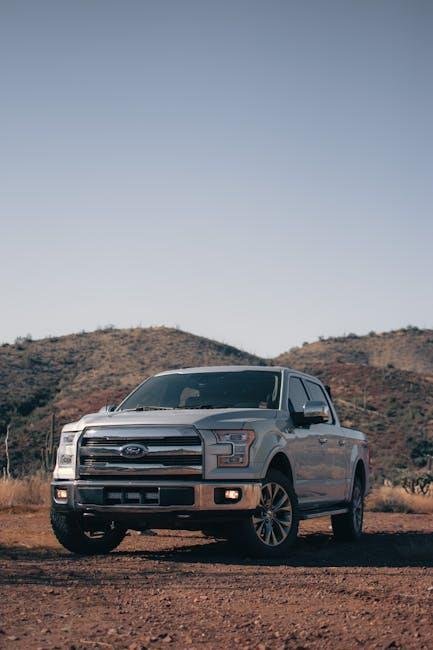In the ever-evolving world of pickup trucks, two titans reign supreme: the Ford F-150 and the RAM 1500. Each boasting a storied legacy, innovative features, and a loyal following, these models vie for the hearts—and pickup beds—of drivers across the nation. Whether you’re hauling heavy loads, navigating rugged terrain, or simply seeking a reliable companion for your daily commute, the choice between these formidable trucks can be as challenging as it is exciting. In this article, we delve into the specifications, performance, design, and technology of the Ford F-150 and RAM 1500, setting the stage for a head-to-head analysis that will help you navigate the competitive landscape of full-size trucks. Buckle up as we embark on this journey to uncover which of these heavyweights truly deserves the title of king of the road.
Comparing Performance and Capability of Ford F-150 and RAM 1500
The fierce rivalry between the Ford F-150 and RAM 1500 continues to capture the attention of truck enthusiasts and potential buyers alike. when it comes to performance, both trucks offer commendable attributes, but they cater to different needs. The Ford F-150 is renowned for its robust towing capacity, often exceeding 13,000 pounds, thanks to its powerful EcoBoost engines. In contrast, the RAM 1500 shines in comfort, offering superior ride quality and a smooth handling experience. Its available eTorque mild-hybrid system enhances efficiency, contributing to lower fuel consumption without compromising performance. Here’s a quick look at their top capabilities:
- Ford F-150: High towing capacity, diverse engine options
- RAM 1500: Superior ride comfort, efficient hybrid technology
In terms of capability, both trucks come equipped wiht advanced technology features that tailor to the needs of modern drivers.The Ford F-150 boasts a state-of-the-art Pro Power Onboard system, which allows owners to use their truck as a generator for tools and outdoor activities. Meanwhile,the RAM 1500’s Multilink rear suspension provides enhanced stability,ensuring a smooth ride even under heavy loads. Additionally, the interior of the RAM 1500 offers a high-end feel with luxurious materials, whereas the F-150 promotes practicality with its durable, user-amiable design. A side-by-side comparison emphasizes their strengths:
| Feature | Ford F-150 | RAM 1500 |
|---|---|---|
| Towing Capacity | up to 13,000 lbs | Up to 12,750 lbs |
| Fuel Efficiency | High, with EcoBoost options | Enhanced with eTorque |
| Interior Quality | Durable & practical | Luxurious & comfortable |

Interior Comfort and Technology: Which Truck Reigns Supreme
The cabin of both the Ford F-150 and RAM 1500 exudes a sense of modernity and comfort, catering to the needs of today’s truck enthusiasts. The F-150 boasts superior materials with an optional luxury interior featuring leather-trimmed seats and wood accents that enhance its upscale vibe. On the technology front, Ford’s SYNC 4 infotainment system makes a striking impression, offering a responsive touchscreen interface along with seamless smartphone integration. Not to be outdone, the RAM 1500 counters with its stylish interior, complete with high-quality upholstery and an available panoramic sunroof that brightens the space. RAM’s Uconnect system is user-friendly, supporting voice commands and providing quick access to Navigation and music streaming.
The comfort and tech features of these trucks are further distinguished by several unique offerings. Here are some highlights:
- Ford F-150: Adaptive cruise control, a premium Bang & Olufsen sound system, and heated rear seats for added luxury.
- RAM 1500: An available 12-inch touchscreen, a rear-seat entertainment system, and class-leading legroom that transforms long trips into pleasurable journeys.
| Feature | Ford F-150 | RAM 1500 |
|---|---|---|
| Infotainment System | SYNC 4 | Uconnect |
| Interior Material Options | Leather & Wood Accents | High-Quality Upholstery |
| unique Tech Features | Adaptive Cruise Control | 12-Inch Touchscreen |

Towing and Payload: A Detailed Look at Truck strengths
When comparing the Ford F-150 and the RAM 1500, both trucks boast notable towing and payload capabilities that make them contenders in the pickup truck segment. The Ford F-150 leads the pack with a towing capacity of up to 14,000 pounds when properly equipped, thanks to its advanced technology and high-strength aluminum body. Not to be outdone, the RAM 1500 offers a robust towing capacity of 12,750 pounds, featuring its exclusive eTorque system that enhances performance on the road. Both trucks are engineered for strength and durability, making them ideal for both work and recreation.
In terms of payload capacity, the Ford F-150 excels with a maximum payload of 3,325 pounds, allowing drivers to carry more gear or materials without breaking a sweat. The RAM 1500, while slightly lower in maximum payload at 2,300 pounds, compensates with innovative storage solutions, ensuring that users have versatile options for organizing their equipment. To summarize, here’s a quick comparison of the towing and payload capacities:
| Truck Model | Towing Capacity | Payload Capacity |
|---|---|---|
| Ford F-150 | Up to 14,000 lbs | Up to 3,325 lbs |
| RAM 1500 | Up to 12,750 lbs | Up to 2,300 lbs |

Cost of Ownership: Analyzing Value and Long-term Expenses
When considering the total expenditure over time for the Ford F-150 and RAM 1500, a variety of factors come into play. While both trucks boast impressive capabilities, their ownership costs can vary significantly based on factors such as fuel efficiency, insurance rates, and maintenance expenses. For instance,one of the primary elements influencing long-term ownership is fuel economy. Drivers may lean towards the Ford F-150’s EcoBoost engine options, known for providing better miles per gallon, especially in highway conditions, but the RAM 1500 has made strides in offering hybrid engines that can also help in reducing fuel expenditures, especially for city driving.
The comparative analysis of insurance costs also plays a crucial role in the overall financial assessment of these vehicles. Typically, the Ford F-150 might have slightly lower premiums due to its higher sales volume and familiarity among insurers. However, RAM 1500’s robust safety ratings may also offer some savings on insurance as many companies provide discounts for vehicles with advanced safety features. Moreover, when examining maintenance costs, users frequently enough report that the Ford tends to have more readily available parts which can result in lower repair costs. To provide clear insight, here is a concise table detailing some key factors:
| Cost Factor | Ford F-150 | RAM 1500 |
|---|---|---|
| Average Fuel Economy (MPG) | 20-25 | 19-24 |
| Estimated Annual Insurance Cost | $1,200 | $1,250 |
| average Maintenance Cost (Annual) | $500 | $550 |
In Summary
As we wrap up our exploration of the Ford F-150 and RAM 1500, it’s clear that both trucks have carved out impressive identities in the ever-competitive landscape of full-size pickups. Each model brings a unique blend of power, technology, and comfort that caters to different needs and preferences, from the hardworking contractor to the weekend adventurer.
In this battle of titans, the choice ultimately comes down to what you value most in a truck—whether it’s the F-150’s extensive suite of features and options or the RAM 1500’s luxurious interior and refined ride quality. As you navigate the rugged terrain of the automotive market, remember that a test drive can be the ultimate deciding factor.
Whichever path you choose, both the Ford F-150 and RAM 1500 stand ready to tackle whatever challenges lie ahead, embodying the spirit of American engineering and resilience. So, whether you’re hauling a heavy load or embarking on a new adventure, rest assured that you’re seated behind the wheel of a vehicle that promises to deliver on performance and reliability. Happy truck shopping!


